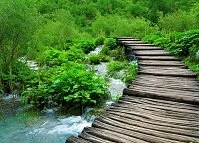Weather

Path in the forest
Croatia's seasons are very distinct and the coast gets an incredible amount of rain. Winters (December-February) can be cold in the mountains, but fairly temperate on the coast. Dubrovnik averages about 50˚ F (10˚ C), while Zagreb stays right around the freezing point. The mountains get a fair amount of snow, but not as much precipitation as the coasts get rain. This snow can last into May or June in the mountains.
The spring and fall (autumn) are much nicer on the coasts as temperatures are warmer, but often times the waters of the Adriatic Sea are still cool as the air temperature may follow suite.
When summers arrive the snow in the mountains should be gone and temperatures rise along the coast, with Dubrovnik boasting daily average temperatures of 78˚ F (25˚ C) and daily highs a few degrees warmer.
Wildlife
Despite its small size, Croatia has a huge diversity in wildlife, but that is a result of their geographic diversity. Most of their large mammals live in the mountains, including wolves, lynx, and bears. There are also sheep, goats, and hundreds of smaller mammals as well.
Along the coast there are also numerous mammals, but the birds and sea life here are what really stand out. There are hundreds of bird that live or migrate through the country including the eagle and many water fowl, including storks, pelicans, heron, and ibis. In the Adriatic there are numerous fish species, but also sea turtles and mammals like dolphins as well.